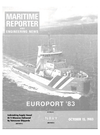
Page 28: of Maritime Reporter Magazine (October 15, 1983)
Read this page in Pdf, Flash or Html5 edition of October 15, 1983 Maritime Reporter Magazine
The Bremen
NATO FRIGATES
Current Situation And Future Design Trends by Dr. Ugo Mazza, General Secretary,
Ente Promozione Industria Navale (EPIN)
Transatlantic reinforcement and resupply would be a critical factor in the conventional defense of
Central Europe. Even considering major improvements now planned in airlift and pre-positioning of materiel, the bulk of equipment and resupply would have to come by sea. In addition, the economic survival of European members of the North Atlantic Treaty Orga- nization (NATO) depends on trade and raw materials from overseas; more than 90 percent of the im- ports of these countries moves by sea.
The Warsaw Pact countries are not dependent on sea transport of imports or exports, and it is impos- sible to interpret the massive buildup of the Soviet Navy as other than offensive in strategic concept. For this purpose, the
U.S.S.R. has amassed a fleet of more than 400 modern subma- rines, four aircraft carriers and a battle cruiser, with more of these types to follow. The Soviet Navy also has 40 or more cruisers and a large number of destroyers, frig- ates and smaller ships. The naval air arm numbers more than 1,500 aircraft.
A recent NATO document syn- thesizes the strategic scenario for
North Atlantic naval defense, which could also be applied to the
Mediterranean flank of the alli- ance. The main wartime task of the growing Soviet fleet is seen as (continued on page 30)
Write 119 on Reader Service Card Maritime Reporter/Engineering News

 27
27

 29
29
